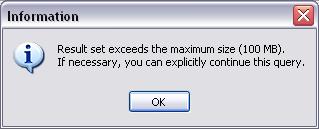Solution of problem: Resultset Exceeds the Maximum Size (100 MB)
I was running a select statement in PL/SQL Developer. it was a short query but the data volume that the query was fetching was huge. But when ever i Click the button Fetch Last Page or press 'ALT+End' button a message box comes after a while saying:

Then I started looking for the exact reason of this sort of problem in Google. When I realized there was no direct solution in the web, I started looking the PL/SQL Developer Software menu and found the ultimate solution.
The reason of this problem is there is a parameter of maximum result set size in PL/SQL Developer Software which is by default set to 100 MB. To change this parameter you have to go to the following location:
1. Goto Edit Menu and click 'PL/SQL Beautifier Options'. A new window will open.
2. Click SQL Window of "Window Types".
3. Now Change the value of "Maximum Result Set Size( 0 is unlimited)" at Record Per Page section
If you provide zero then the size will be unlimited.
Thanks for reading this article.
good day.
:-)
ReplyDeleteVery help full to fetch LOB Values..
ReplyDeleteTHANKS SK....
ReplyDeletehappy to help...
thanks dude...you saved my day
ReplyDeleteVery useful
ReplyDeletepesumgeoya Wendy Young https://www.consciousyou.net/profile/yedydazephyrwharton/profile
ReplyDeletejoisturellei